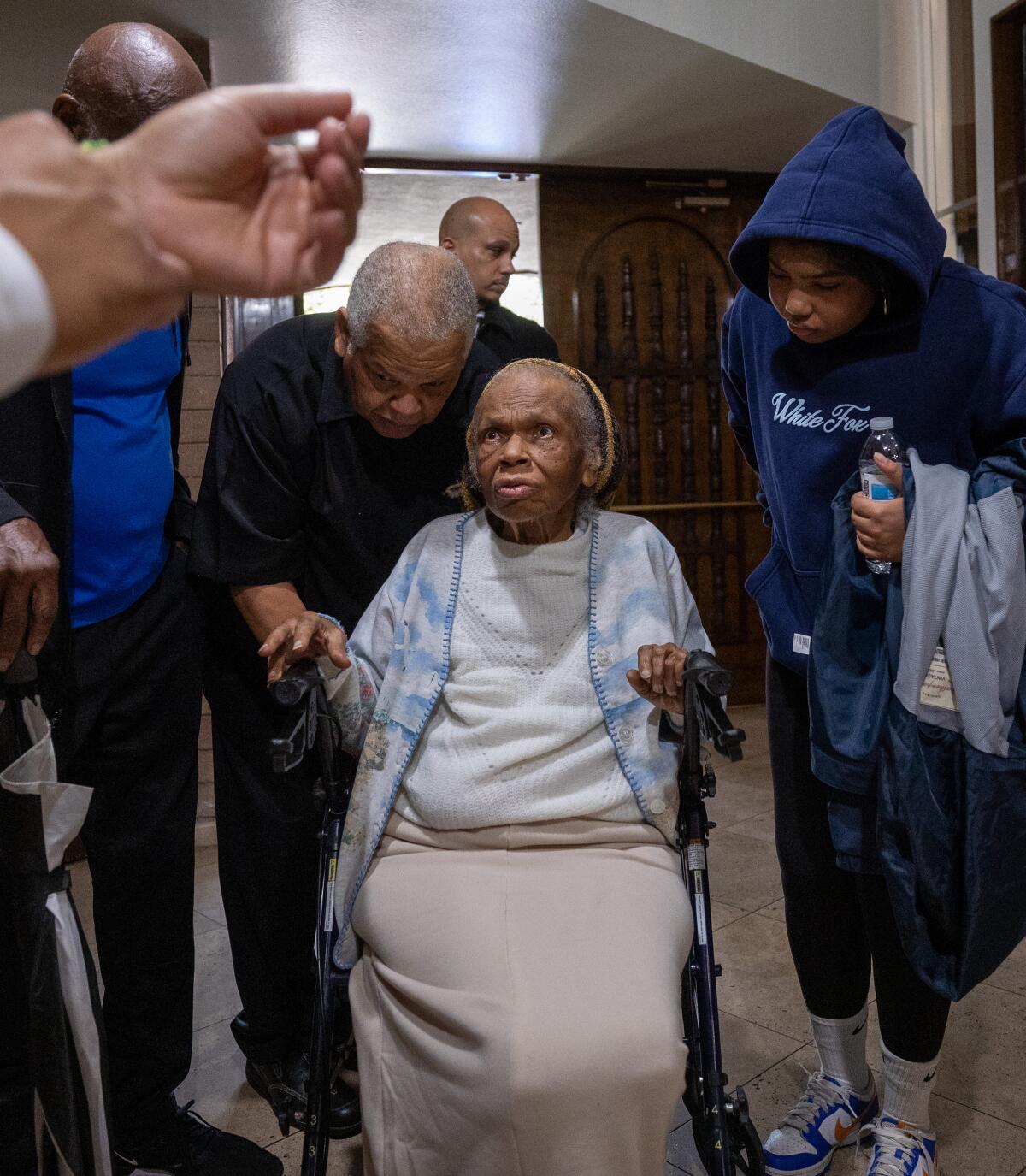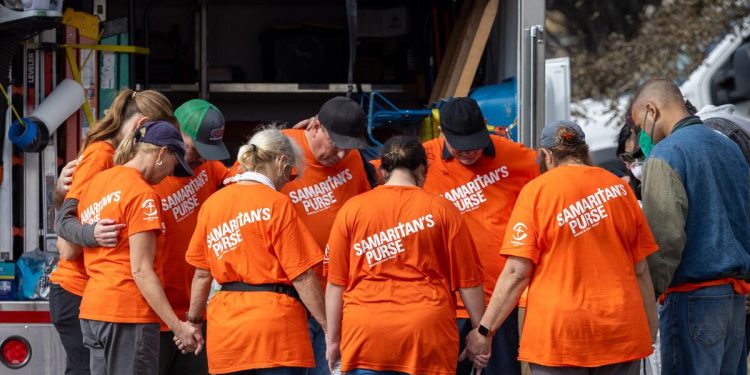When forest fires have swept Los Angeles, people and businesses around the world responded by opening their portfolios in a way that has broken generosity records.
Money has paid thousands of different recipients, venerable non -profit organizations such as Centraide and Habitat for Humanity, to individual families via GoFundme, to specialized groups working to replace burnt musical instruments and animals in plush.
The range of organizations puts a specific count of the difficult philanthropic dollars, but the amount collected and promised during the last month exceeds $ 650 million, according to interviews with non -profit executives and fundraising efforts announced publicly.
This seems to establish a fundraising record for forest fires and exceeds data for recent natural disasters. Charitable contributions for MAUI 2023 fatal fires have totaled around $ 450 million, according to a database compiled by Honolulu Civil Beat. The collection of funds for hurricanes Milton and Helene, who devastated the south-east of the United States last year, exceeded $ 278 million, according to a partial tab of the candied philanthropy site.
Some of the remains of Tiffany Hockenhull’s home are presented on January 23 in Altana.
(Nick Agro / for time)
The effusion of charitable for January fires reflects the extent of destruction in the palisades and in the Altadena region, the people of the connection distant from California in Los Angeles and Hollywood, and in place of celebrities As survivors and fundraising.
The musicians of the Grammy Awards of February 2 called on donations. Billie Eilish, Stevie Wonder, Red Hot Chili Peppers and others performed at the Fireaid Benefit concert last week. Together, the organizers estimate that they will bring back more than $ 125 million.
How will all this money be spent?
Hundreds of millions of dollars have already done so. According to company data, online fundraising via Gofundme have put more than $ 200 million in the hands of families and people who have lost houses and livelihoods and related causes.
Many non -profit organizations have also quickly converted the contributions into cash for evacuated and others affected by fires.
“I literally driven it with checks of checks,” said Wade Trimmer, president of the change of change, a charitable organization based in Sherman Oaks which distributed about $ 5 million in direct assistance. Trimmer said that confessional and community groups have identified more than 2,300 people to receive subsidies between $ 1,500 and $ 2,500.

Evelyn Cathirell entered a commemorative service at First AME Church Thursday in Pasadena. His daughter Evelyn McClendon died in Eaton’s fire in Altadena.
(Brian van der Brug / Los Angeles Times)
About 80% of the recipients of the Pasadena region were old, he said, adding: “We had people during our events that came to us and saying:” I will use this gift card immediately because that I need food tonight. ‘”
The Los Angeles Regional Food Bank, which collected $ 5 million, has created distribution sites in East La, Irwindale and elsewhere and extended its operations from six to seven days a week.
“We have operated almost every day and longer days to be able to cope with an increased volume,” said Michael Flood, managing director of the food bank. Sometimes he said, “The late quarter -work met the first quarter of work the next day.”
Only two days after fires, a group of non -profit organizations established the Dena Relief Drive to distribute emergency supplies: shoes, clothes, laptops for students whose computers burned in fires and cards -Cadeaux totaling $ 80,000 to pay for grocery store, accommodation and a multitude of expenses inciprogne faced by people who have lost their homes.
“We had some families who had children with eczema, and they needed a certain type of lotion, and we were able to give gift cards for that,” said organizer Brandon Lamar.
California Community Foundation helped take out the effort. The philanthropic giant raised $ 60 million in the month following the fire and has distributed half of it by next week, the organization said.
The Foundation gave $ 100,000 to 11 places of worship destroyed by fires, including the Saint-Marc episcopal church in Altadena. The late Eaton has torn his school campus and church, burning nine buildings and at least 40 members have lost their house.
“It was sort of breathtaking,” said Reverend Carri Patterson Grindon to receive the grant. The church has reserved money for members with daily expenses and beyond the start-up reconstruction. “It is our intention to rebuild. We just don’t know what it will still look like.
Even with the funds spent in immediate compensation, a large amount of charity remains. Non-profit leaders gathered to discuss the moment and how to go to mid-term and long-term recovery efforts.
A month after fires, around 300 people were still in a Red Cross refuge in Pasadena, a certain number in the philanthropic community look as metric, said Lily Bui, who followed fundraising at 20 foundations Established for Socal Socal Grantmakers Socal.
“Once this number reaches zero, then we can speak significantly about recovery,” said Bui.
Meanwhile, charities have heard experienced people in reconstruction after natural disasters. One is Jennifer Gray Thompson, whose non-profit organization after the United States advised Maui, Paradise and other communities upset by forest fires to navigate the reconstruction process.
“We want them to plan, really, for seven years of funding,” said Thompson, adding that she encouraged the foundations to see recovery as “a sprint marathon” and keep enough money to help long term. “You cannot really start a program for an unprecedented disaster, and you expect it to achieve its results in a year.”

The crews dressed in hazardous material outfits clean the toxic debris in a house after being destroyed in the fire Eaton on Wapello street in Altadena on February 4.
(Allen J. Schaben / Los Angeles Times)
Charitable expenses take place in parallel with an influx of other money for reconstruction: billions of dollars of federal aid expected, individual insurance regulations and potential payments of a myriad of prosecution.
Even within the philanthropic community, the landscape could be complex. Local long -standing foundations and new initiatives, such as those launched by local billionaires Rick Caruso and Evan Spiegel, determine how to deploy their resources.
In Maui, the major foundations have set up a collaboration to give money, but there is no current plan for a tsar or a charity committee
“I think there is a lot of effort to share what people do … so that duplication can be avoided,” said Jennifer Devoll, president of the Pasadena Community Foundation.
The first discussions on how to spend money included mental health services for the first stakeholders and survivors, the training of displaced workers for construction jobs, subsidies for under-assured and landed trusts to discourage the Speculators.
Several non-profit leaders said that, in a disaster that affected people of all socio-economic levels, charities were better spent for the poor and marginalized.
“Recovery systems are designed for people who have the capacity to navigate a very complicated system. They are not designed for the most vulnerable, “said Miguel Santana, CEO of California Community Foundation who is also part of Spiegel’s Venture, Department of Angels.
A case management system in the event of a disaster which will collect in -depth information on the specific situations of thousands of families and individuals should accelerate in the coming months and provide additional information to philanthropic institutions.
“This is what all non -profit organizations will be championed to the bit,” said Jenni Campbell, executive director of the community takeover organization in the region. “What are the unsatisfied needs?”
California Daily Newspapers


